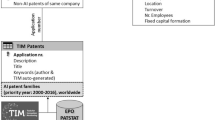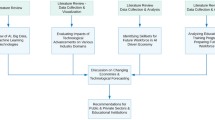Abstract
The aim of this article is to develop new patent indicators for evaluating technological innovation competitiveness between companies. A novel indicator representing an industrial’s patent performance, Essential Patent Index (EPI), was developed by incorporating information on who cited these patents and when these patents were cited, based on the assumption that both contribute to meaningful quality assessment. By combining EPI and Chi’s well known Technological Strength (TS) indicator, a second novel indicator Essential Technological Strength (ETS) was developed to represent the innovation competitiveness of an individual company. In this study, patent performance of three high-tech industries in Taiwan were analyzed using ETS as well as the traditional TS for comparison. Results from this analysis demonstrated that ETS provided better insights by clearly verifying the latent influence of citations, reinforcing the impact of essential patents, and aggrandizing the differences of innovation competitiveness between companies.
Similar content being viewed by others
References
Acosta, M., Coronado, D. (2003), Science-technology flows in spanish regions: An analysis of scientific citations in patents. Research Policy, 32: 1783–1803.
Albert, M. B., Avery, D., Narin, F., McAllister, P. (1991), Direct validation of citation counts as indicators of industrially important patents. Research Policy, 20: 251–259.
Albert, M. B., Yoshida, P. G., Opstal, D. (1998), The New Innovators: Global patenting trends in five sectors. U.S. Department of Commerce, Office of Technology Policy. Retrieved October 12, 2004 from: http://www.technology.gov/Reports/09111998.pdf
Breitzman, A. F., Narin, F. (2001), Method and apparatus for choosing a stock portfolio, based on patent indicators, United States Patent, 6175824.
Chen, D.-Z., Huang, M.-H., Lin, W.-Y. C. (2003), The Industrial technological Innovation Scoreboard: Evaluating by number of patents and citation. Taiwan Economic Research Monthly, 26: 87–93. (in Chinese)
Dunlop, L., Oppeinheim, C. (1980), The effect of recycling on a patent citation network. World Patent Information, 2(3): 100–102.
Ellis, P., Hepburn, G., Oppenheim, C. (1978), Studies on patent citation networks. Journal of Documentation, 34(1): 12–20.
Garg, K. C., Padhi, P. (1998), Scientometric study of laser patent literature. Scientometrics, 43: 443–454.
Hagedoorn, J., Cloodt, M. (2003), Measuring innovative performance: Is there an advantage in using multiple indicators? Research Policy, 32: 1365–1379.
Hall, B. H., Jaffe, A., Trajtenberg, M. (2000), Market value and patent citations: A first look. NBER Working Paper, No. w7741.
Hirschey, M., Richardson, V. J. (2004), Are scientific indicators of patent quality useful to investors? Journal of Empirical Finance, 11(1): 91–107.
Hu, A. G. Z., Jaffe, A. B. (2003), Patent citations and international knowledge flow: The cases of Korea and Taiwan. International Journal of Industrial Organization, 21(6): 849–880.
Karki, M. M. S. (1997), Patent citation analysis: A policy analysis tool. World Patent Information, 19(4): 269–272.
Koenig, M. E. D. (1983), A bibliometric analysis of pharmaceutical research. Research Policy, 12(1): 15–36.
Meyer, M. (2002), Tracing knowledge flows in innovation systems. Scientometrics, 54(2): 193–212.
Narin, F., Olivastro, D. (1998), Linkage between patents and papers: An interim EPO/US comparison. Scientometrics, 41: 51–59.
Narin, F., Albert, M., Kroll, P., Hicks, D. (2000), Inventing Our Future: The Link Between Australian Patenting and Basic Science. Commonwealth of Australia. Retrieved October 12, 2004 from: http://www.arc.gov.au/pdf/00_02.pdf
Narin, F., Noma, E., Perry, R. (1987), Patents as indicators of corporate technological strength. Research Policy, 16(2–4): 143–155.
Nunn, H., Oppenheim, C. (1980), A patent-journal citation network on prostaglandins. World Patent Information, 2(2): 57–60.
Rozhkov, S., Ivantcheva, L. (1998), Scientometrical indicators of national science & technology policy based on patent statistics data. World Patent Information, 20(3–4): 161–166.
Technology Review & CHI Research (2004), 2004 Technology Review Patent Scorecard. Retrieved January 15, 2005 from: http://www.technologyreview.com/articles/downloads/patents0504.xls
Trippe, A. J. (2003), Patinformatics: Tasks to tools. World Patent Information, 25(3): 211–221.
World Economic Forum (2004), Global Competitiveness Report 2004–2005: Executive summary. Retrieved Jan. 10, 2005 from: http://www.weforum.org/pdf/Gcr/Executive_Summary_GCR_04
World Bank (2005a), Knowledge Assessment Methodology (KAM) Home Page. Retrieved Aug. 26, 2005 from: http://info.worldbank.org/etools/kam2005/
World Bank (2005b), Basic Scorecard. Retrieved Aug. 26, 2005 from: http://info.worldbank.org/etools/kam2005/html/basic_scorecard.htm
Wu, R.-I. (2000), The Measurement and International Competitiveness of a New Taiwan Economic Indicator. Retrieved December 10, 2004 from: http://www.tier.org.tw/07publication/president/28.htm (in Chinese)
Author information
Authors and Affiliations
Corresponding author
Rights and permissions
About this article
Cite this article
Chen, DZ., Lin, WY.C. & Huang, MH. Using Essential Patent Index and Essential Technological Strength to evaluate industrial technological innovation competitiveness. Scientometrics 71, 101–116 (2007). https://doi.org/10.1007/s11192-007-1655-6
Received:
Issue Date:
DOI: https://doi.org/10.1007/s11192-007-1655-6




